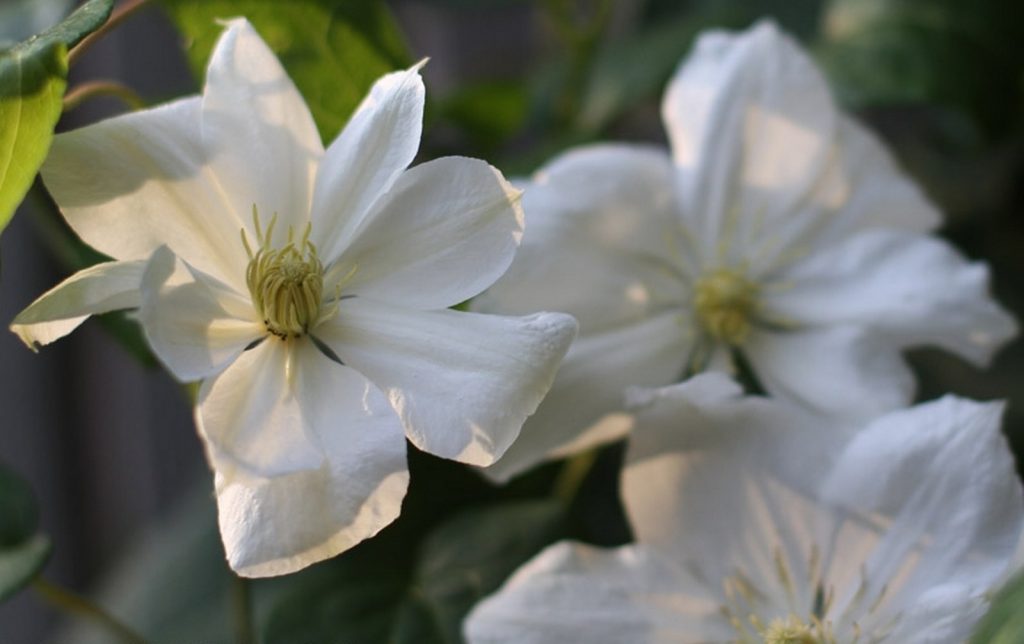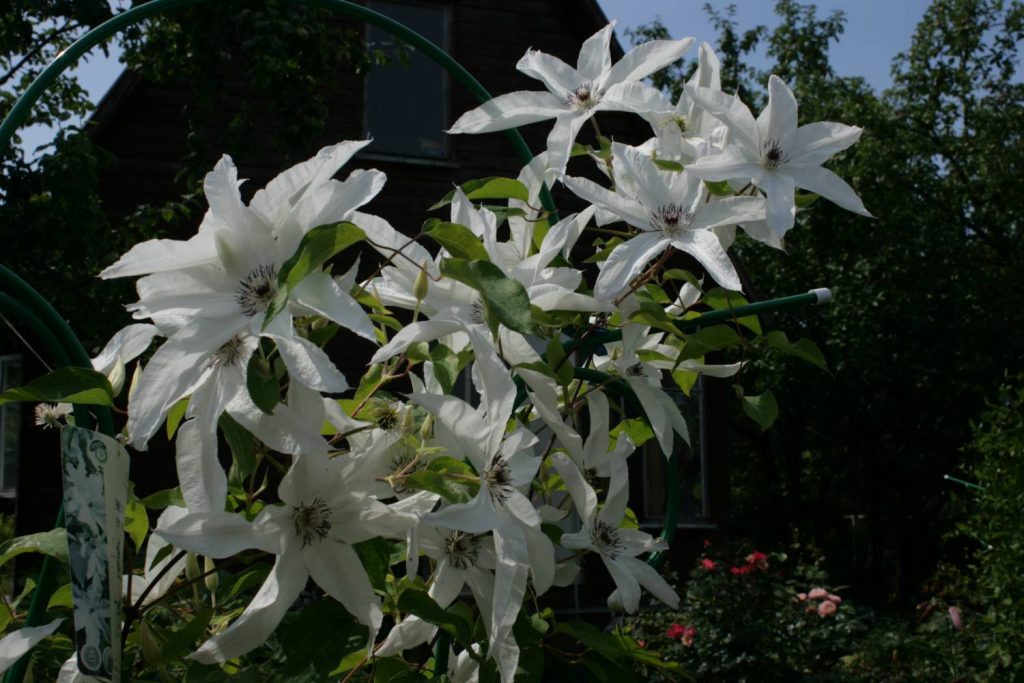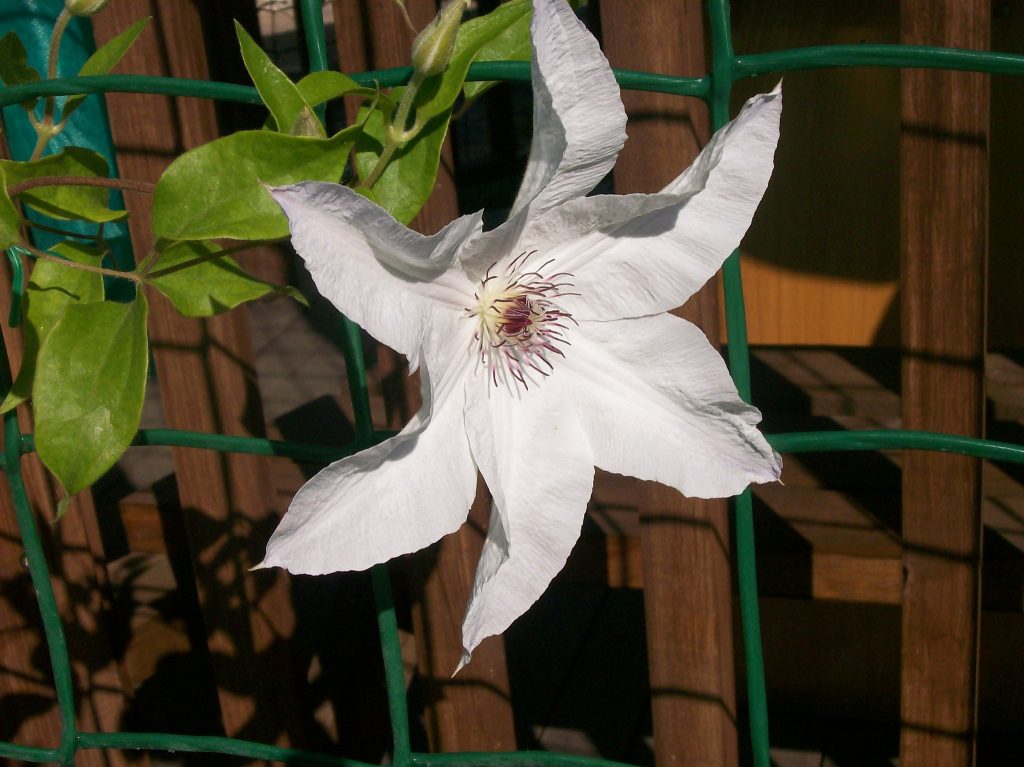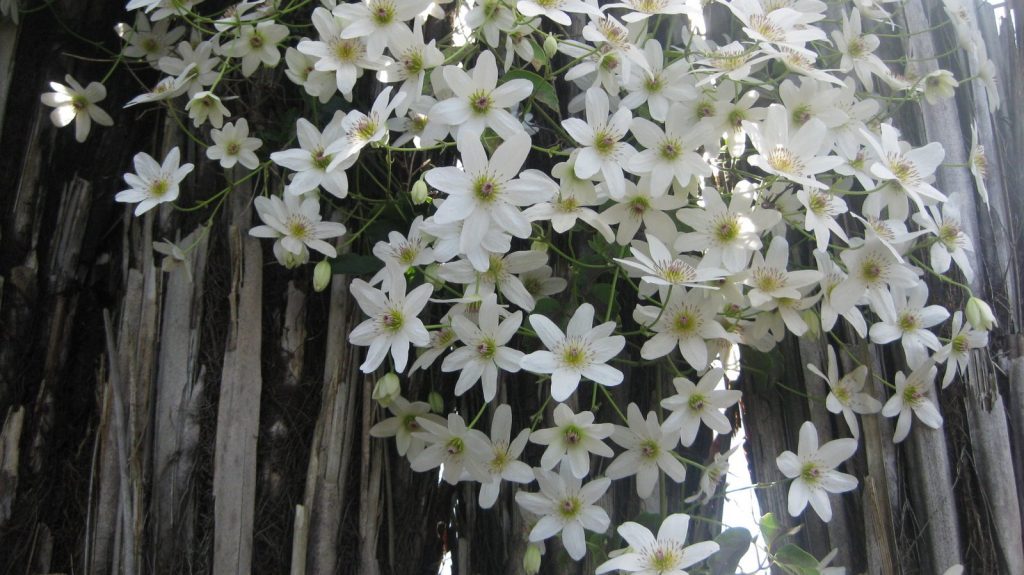Clematis Beauty Bride - full characteristic of the variety
Large-flowered clematis Beauty Bride is a spectacular decorative perennial from the Buttercup family. The hybrid variety was bred in Poland in 2011 (originator - S. Marchinsky). The name translates as "Beautiful Bride", emphasizing the beauty of the amazingly large and delicate flowers.

Clematis Beauty Bride
Description of the plant
Clematis Beautiful Bride is a perennial bush with long, creeping shoots, which makes it a member of the lianas group. Tied to a support, it reaches a height of 1.5-3 m.
Very large white flowers often cover small, light green leaves. The diameter of such a flower is 15-25 cm.
The petals are snow-white, wavy at the edges, with a pointed tip. The middle is made up of lemon stamens with purple-violet binders.
Flowering occurs in two stages: May-June and August. In the first wave, flowers appear on the shoots of the last year, and in the second - this year.
Landing features
Clematis can be planted in spring, summer and autumn, but it is important to remember some of the nuances.

Clematis Beauty Bride reviews
- Spring planting is best done at the very beginning of the growing season.
- Summer - only for container seedlings, transferring them together with an earthen clod.
- In autumn, you need to be in time a month before the first frost.
Sapling selection
It is advisable to purchase a seedling rooted from a cutting. When dividing the bush and propagating by layering, the risk of inheriting the disease of the mother bush is higher.
It is better to buy two-year copies and at the same time check the quality of the goods: the plant should not have dry shoots, mechanical damage, extraneous deposits and stains.
Pick-up location
Beauty Bride loves light partial shade or diffused sunlight with midday shade. The plant prefers fertile, loose soil with a reaction - from slightly alkaline to slightly acidic.
If water from precipitation accumulates on the site, it is necessary to lay drainage from small stones or broken brick into the pit. In addition, the landing site must be well protected from the wind.
The distance to walls, fences and the nearest perennials is 70-80 cm.
Technology:
- Dig a landing hole 60-70 cm deep and wide.
- If necessary, drainage is laid on the bottom.
- The removed soil is mixed with organic and mineral fertilizers (compost, rotted manure, peat, ash, superphosphate, etc.)
- The substrate is poured with a slide, on which the plant is placed, spreading the roots down the hill; watered.
- The rest of the soil mixture is poured, deepening the root collar by 8-10 cm.
- Another watering is carried out, and the soil is mulched with sawdust, peat or pieces of bark.
- A support is installed and a seedling is tied to it.
Care
For all the beauty and exoticism, Beautyful Bride cannot be called too whimsical plant. Caring for him consists in watering, feeding, pruning and sheltering for the winter.As new shoots grow, they need to be carefully tied to a support.

Clematis Beauty Bride description
Watering
Young plants are watered 1-2 times a week, directing the stream strictly to the root. In this case, 4-8 liters of water are used per bush. Adult clematis need more rare, but abundant watering (2-3 times a month, 15-20 liters).
Top dressing
In the first season, the young plant is not fed. In early spring, after wintering, ammonium nitrate or urea is applied, at the beginning of the primary and second flowering - complex mineral fertilizers. In September, it is useful to spray the shoots with a phosphorus-potassium solution.
Trimming group and technology
Since the flowers of Beautyful Bride grow on the shoots of the past and current season, it needs a weak pruning (second group). It is carried out in two stages - in early June and late autumn.
The technology is very simple: with a disinfected pruner, the stems with leaves are cut, leaving the height of the bush 150-100 cm. Once every 4-6 years, it is recommended to do a more global haircut.
Preparing for winter
To avoid root flooding (after the snow has melted), a 40 cm high hill of earth is poured under the clematis in the fall. The bushes are covered with spruce branches or dry leaves. You can put a box on top or put slate.
Reproduction
Clematis Beauty Bride reproduces by layering, dividing the bush and cuttings. Since the variety is hybrid, decorative characteristics are not preserved when sowing seeds. The most popular method among gardeners is cuttings.

Clematis Beauty Bride photo
Cuttings
Cut a stalk with one knot, two leaves and buds. A 10 mm stem is left above the nodule, and one leaf is removed to reduce moisture evaporation. The substrate for rooting is prepared from two layers: the lower one is fertile soil, the upper one is coarse-grained sand. Having previously moistened it, the cuttings are deepened.
From above, the container is closed with a film or lid to maintain high humidity and a comfortable temperature. Every day the "greenhouse" is ventilated. When the axillary buds in the node wake up, this is a sign that rooting has taken place.
Dividing the bush
You can divide the bush only 5 years after planting. Clematis is dug up and divided into several parts with an equal volume of roots and the number of buds. Then the cuttings are planted in the usual way in the nutrient soil in light partial shade.
Avoiding shoots
The soil next to the bush is combined with sand and ash, loosened, watered. The shoot is bent with a knot to the ground (the leaves are first removed on it) and fixed with a wire (or a bracket). A mound of wet coarse sand is poured on top. Rooting occurs in 5-7 weeks. During this period, the layers are regularly moistened.
Diseases and pests
| Problem | Symptoms | Prophylaxis | Treatment |
| Aphid | Light green bugs. Leaves curl, deform and dry out. | Correct watering regime. Avoid the appearance of anthills next to clematis. Plant calendula in the neighborhood (it attracts ladybugs that eat aphids). | Cut off deformed leaves, wash the plant with soapy water. Use insecticides for serious injury (Inta-vir, Fas, Karate). |
| Powdery mildew | White bloom appears, fabrics darken and dry. | Feed the plant with phosphorus and potassium, do not abuse nitrogen. Do not thicken the planting. Remove weeds and fallen leaves in time. | Cut off the affected parts of the clematis. Treat the bushes with manganese solution or Bordeaux liquid. |
| Wilt | Withering of the upper shoots, damage to the bush at the base. | Disinfection of garden tools, cleaning of fallen leaves and weeds. Sprinkle ash on the ground regularly and water with potassium permanganate. | Cut off affected stems and burn. Treat the soil and the remaining healthy parts of the bush with Fundazol or copper sulfate. |
How to use in landscaping
Large-flowered clematis of the Beauty Bride variety is often used in landscape design.Thanks to its ability to trail beautifully along the support, lush flowers and double flowering, this variety is gaining more and more popularity. Usually it is used for vertical landscaping of gardens, summer cottages, courtyards of private houses.

Clematis Large-flowered Beauty Bride
You can grow the plant outdoors or in a container. The latter method helps to create a spectacular plant decor even with a shortage of planting land. Gorgeous white flowers will successfully decorate a gazebo, fence, wall, arch or trellis.
Clematis goes well with a weaving rose, honeysuckle, lemongrass, actinidia, and a variety of conifers.
Variety reviews
Judging by the reviews, the Beautyful Bride variety is very beautiful, not capricious, resistant to diseases, pests and frost. Some gardeners do not cover it at all for the winter, but they cut it shorter. It is noticed that the largest flowers appear at the first flowering in the lower part of the bush.
This vine grows much better and pleases with its decorativeness in light partial shade (than in the open sun or in full shade). In too damp soils, it develops and looks worse. When propagating by cuttings, layering and dividing, problems usually do not arise.

